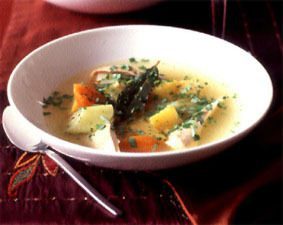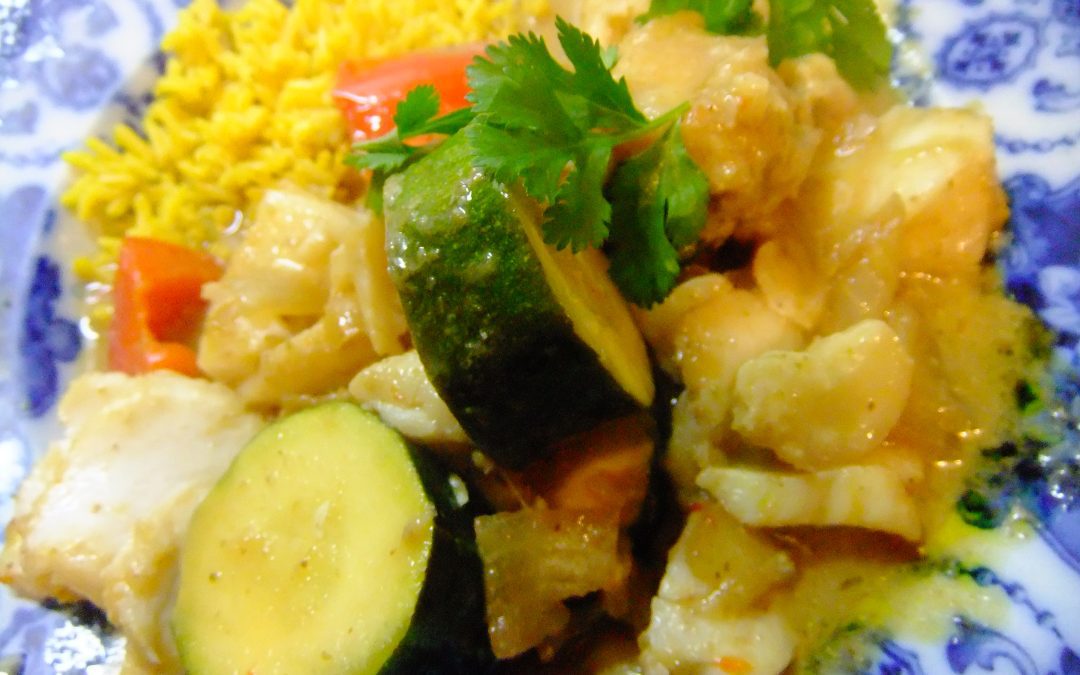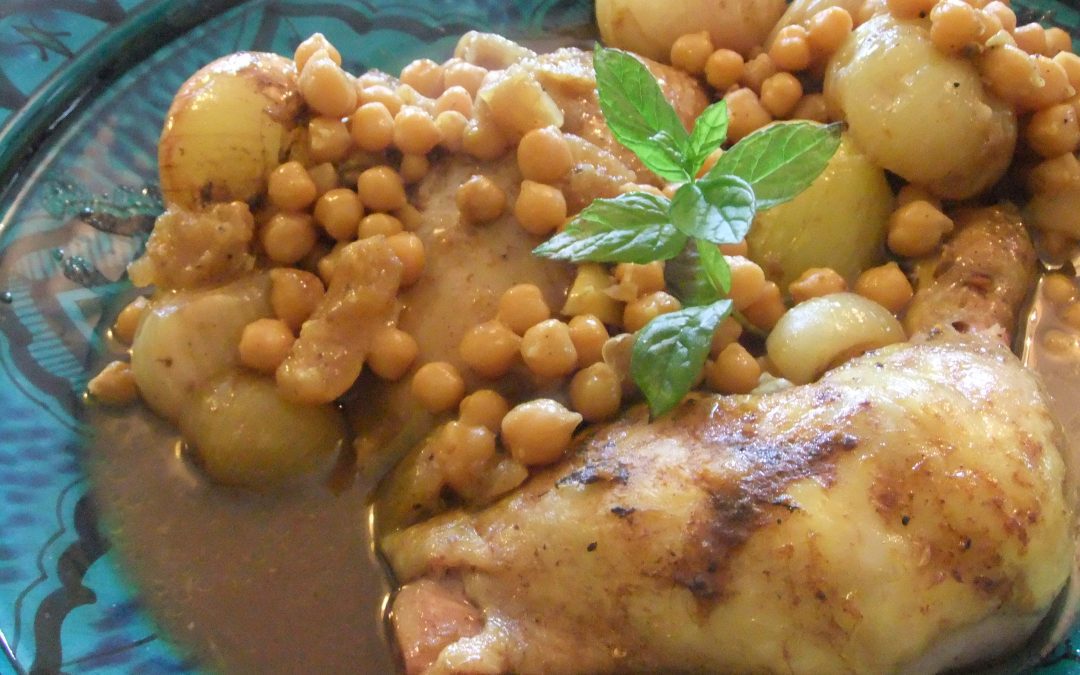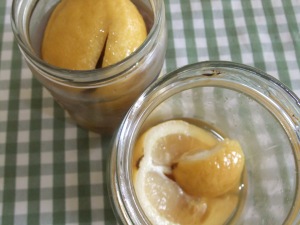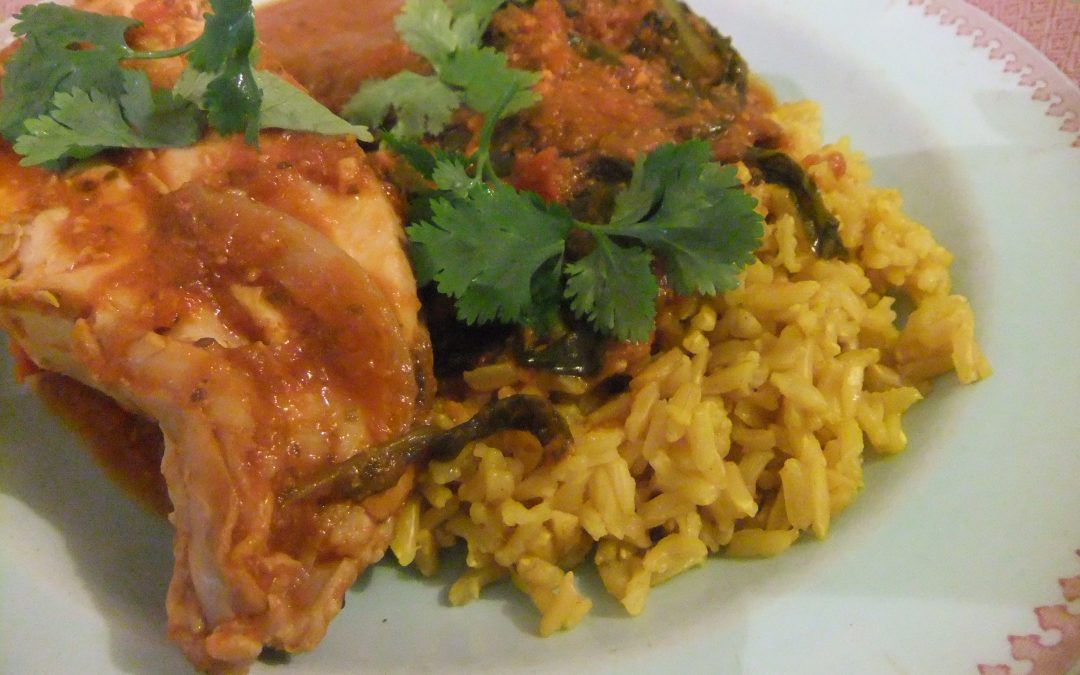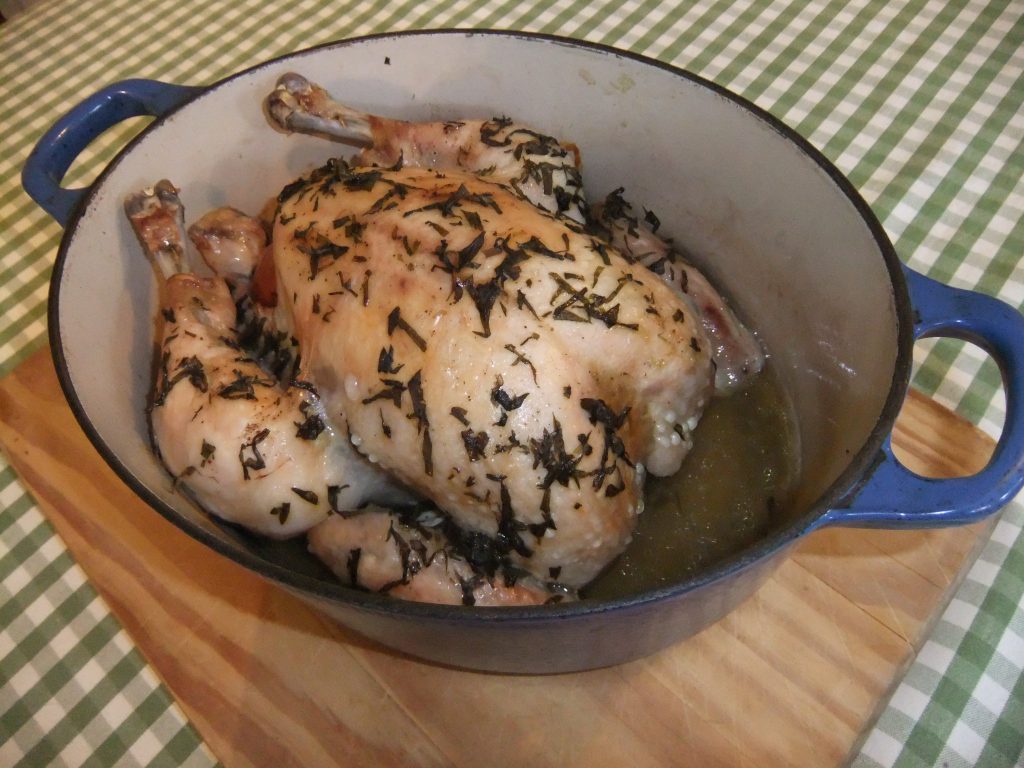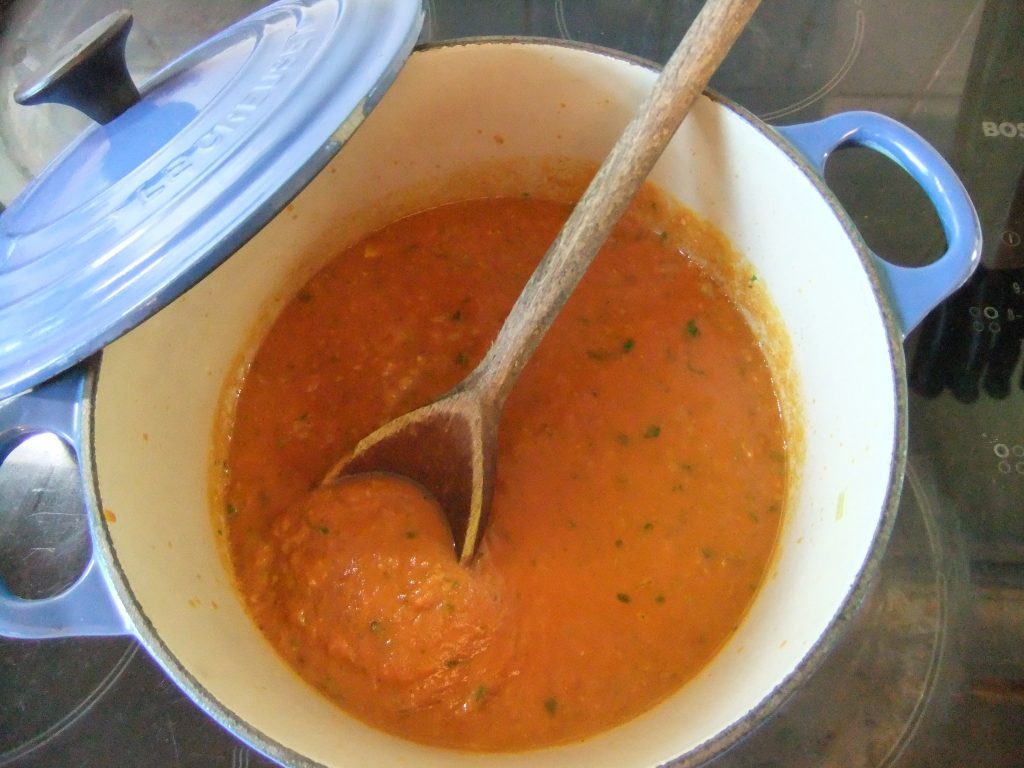
Nov 21, 2024 | Anna's Best Recipes, Main courses
Leftover chicken/turkey and broccoli curry
1 large onion peeled and sliced finely
250 g leftover cooked chicken off the bone, shredded
1 can (400g) chopped tomatoes
2 large cloves garlic, crushed
1 heaped tsp (teaspoon) each of ground coriander + cumin
2 heaped tsp garam masala
Optional chilli powder 1/2 level teaspoon for heat
If you don’t have those spices, 4 tsp gluten-free curry powder will do
1 level dessertspoon virgin coconut oil or ghee
150-200g tenderstem broccoli, cut in 4cm lengths
150g (1 mug to brim) frozen peas
100ml chicken stock or water
100ml (nearly ½ a big can) full fat coconut milk
Salt and Pepper to taste
Optional: fresh coriander leaves to garnish
1. Steam-fry onions: put them with the oil and 1 dsp water into a heavy bottomed saucepan, cover with lid or plate. Cook on medium heat till soft and translucent (around 12 mins). You don’t want them to brown. Browned food is damaging to our health.
2. Add the crushed garlic, spices and stir around for a minute.
3. Add tomatoes, coconut milk and chicken stock/water to the pan and simmer for 10 minutes, stirring regularly till the mixture is a bit thickened. Season to taste.
4. Add chicken, broccoli, put the lid on and cook for a further 5 minutes until the broccoli has changed colour and the chicken is heated through. While you’re waiting for this, pour some hot water over your frozen peas in a strainer to thaw them quickly. Add to the pot a couple of minutes before the end so they’re still an appetizing bright green when you come to eat.
5. Garnish with fresh coriander leaves if you have them.
Serve with:
Low carb (lower carbohydrate = lower sugars): 1 cup cauliflower rice per person
Medium carb (if you do not want to drop weight) brown basmati rice (measure 1/4 mug per person dry weight and cook in twice its volume of boiling water from the kettle).
Variations and swaps:
Instead of the coconut milk use 30g creamed coconut from a block you can buy in Asian shops. Chop it up before adding to the pan with the tomatoes so it doesn’t take ages to melt!. This is very economical cos you just use what you need and keep the rest in the fridge for another time.
Why this is good for you
We’ve all gone a bit fat phobic, culturally. But it is high carbohydrate diets (lots of grains like wheat rice or pasta, potatoes and sugar or fruit juices) that pile on the weight. And cause inflammation in your arteries i.e. heart disease. Refined or heated nut/seed oils are another big driver. So sticking with healthier oils like ghee, coconut milk and olive oil and limiting your carb intake keeps you healthier. Herbs and spices and powerhouses for your health. They are natural anti-inflammatories and alter your gut micro-biome (the micro organisms in our gut we need for health). Alter it in favour of the good guys that regulate weight, blood pressure and every single metric of health, including preventing digestive disorders and diabetes.

Sep 16, 2020 | Anna's Best Recipes, Main courses
This is super-easy and works with turkey or beef mince. It tastes even better the next day and freezes brilliantly too. That’s why I always make enough for 4 and freeze half for one of those “don’t feel much like cooking” nights.
For 4:
2 x 400g tins borlotti or red kidney beans, drained and rinsed (or soak 1 cup raw beans overnight, change water, then boil hard till ender)
2 medium onions (about 350g) chopped
500g lean turkey or beef mince
1 tbs extra virgin olive oil
3 cloves garlic, chopped or crushed
1 heaped tsp ground cumin (or more to taste)
1 heaped tsp plain cocoa powder (optional)
1 level tsp ground cinnamon
1 heaped teaspoon dried oregano (herb)
¼ – ½ tsp ground chilli or cayenne (optional)
1 x 400g tin chopped tomatoes with their juice/400g sieved tomatoes (passata)
1 heaped tbs tomato puree
Good splash (about 60ml) red wine if you have it
1 tsp miso paste OR a beef stock cube, dissolved in 50ml boiling water
Lots of freshly ground black pepper
Generous pinch Himalayan/sea salt
To serve:
Cauliflower “rice” (see recipe on blog) or if you don’t want weight loss you could use rice or millet (instructions on blog)
Steamed broccoli, green beans, peas or a green salad
Plus if you’re feeling fancy some roughly chopped coriander and some lime wedges
1. Heat a large, heavy bottomed saucepan (with lid) on a medium heat.
2. Add the onions, olive oil, small splash (about 1 tbs) water, cover with a lid and “sweat” (cook gently) until the onions are softened, about 10 mins.
3. Add the mince and stir around for a minute to break it up a bit. There is no need to brown it. Then add the garlic, cumin, cocoa, cinnamon, oregano chilli/cayenne, tomatoes with their juice and the miso/beef stock.
4. Cover and cook at a simmer for around 20 mins stirring occasionally, till the meat is cooked. If the sauce begins to dry out you can add a little water or vegetable stock. If theres more liquid then you like, simmer uncovered until until it reduces.
5. Add borlotti/kidney beans and tomato puree and cook for a further 10 mins.
6. Season with freshly ground black pepper and salt.
Why this is good for you:
Turkey and beef are rich in amino acid tryptophan which is a building block of feel-good neurotransmitter serotonin. Serotonin is one of the brain chemicals that makes you feel calm, happy and is essential for sleep (it gets converted to sleep-hormone melatonin). If you have a good balance of healthy gut bacteria AND good levels of certain vitamins and minerals your body will convert tryptophan to serotonin easily. Did you know that low serotonin in your gut can be a trigger for IBS? Not a lot of people know that.
Did you know that ALL herbs and spices have many effects – from helping you see off infections to helping you maintain a healthy weight and age agelessly? These magical taste-bombs also have anti-inflammatory effects, even in your brain (did you know that depression involves brain inflammation?). Herbs and spices selectively encourage growth of good bugs in your gut. AND they make your gut a hostile environment for disease-causing organisms.
When you cook meat WITH spices or herbs, you protect the meat (and whoever eats it) from much of the damage produced by heat. A study of diabetic people monitored blood samples for inflammatory markers before and after eating 2 different types of grilled beef patty. One cooked just with salt and pepper, the other mixed with at least 6 different herbs/spices before cooking. After eating the patties, guess which group had less inflammation in their blood – you guessed it, the herb and spice group. The WAY you cook your food has a massive effects on it’s power to help or derail your health.
This recipe also has onions, which contain the fibre inulin. Inulin feeds beneficial bacteria in your gut. Healthy gut, happy mind, happy life.

Feb 7, 2020 | Anna's Best Recipes, Main courses
I adapted this from a recipe by Raymond Blanc to include more greens and a little less stodge. It makes a lovely, gently flavoured dinner. Even my husband, who says he doesn’t really like meals that involve broth, likes this one.
In my newsletter last month (to people who subscribe for FREE via my website www.annacollins.ie), I talked about why chicken broth can help prevent wrinkles. To make this even more nutritious you could make the following meal using home-made chicken stock (made by boiling organic chicken bones in water and a dash of apple cider vinegar) instead of the water in the recipe. Or use chicken pieces on the bone instead of fillets. I like to make a four-person amount and reheat thoroughly for another dinner later in the week
For 4
3 large carrots, peeled and sliced into bite-sized chunks (about 2cm thick)
1 small (Swede) turnip, peeled, cut into bite-sized cubes
4 small organic chicken legs, 2 breasts on the bone cut in two, or failing that, 4 fillets (but chicken with bones is better)*
6-8cm piece of fresh root ginger, peeled and thinly sliced
4 garlic cloves, peeled and sliced
2 large heads broccoli, cut into florets
Optional extras: (NOT for SC diet): 100g 100% buckwheat noodles/rice noodles (soak in boiling water 5 mins, drain and refresh in cold water until ready to use at the end).
Tamari sauce (this is a gluten-free soya sauce)
1. In a large saucepan cover the turnips and carrots with boiling water and boil for 10 mins.
2. Add the whole chicken fillets, garlic, ginger, making sure all just covered with water and cook (simmer) for 15 minutes.
3. Add the broccoli and cook for a further 5 minutes.
4. Check that the chicken is cooked. When it is done
5. Divide the cold cooked noodles between 4 large bowls. Cut up the chicken fillets into bite-sized slices if you can be bothered.
6. Ladle in the rest of the ingredients on top of the noodles and chicken
7. Provided you are NOT on the SC diet you can add tamari sauce to taste. For SC diet just add more salt and pepper.
Variation (not for SC diet!):
For a mostly vegetarian version, add 100g cubed fermented tofu or tempeh, cut into bite-sized cubes at the same time as the broccoli, and use chicken stock or a chicken stock cube (provided you are not a purist vegetarian!)
Why this is good for you
Swede turnips, carrots and all orange fruits and vegetables are a rich source of carotenoids such as beta carotene. Eating a diet rich in beta carotene and other carotenoids found in green, red and purple vegetables will give your skin an attractive golden glow, according to a study of university student who increased their fruit and veg intake for a few weeks. Beta carotene is also important for clear skin, excellent eyesight and helping prevent wrinkles and digestive problems. The list of its activities is endless so I won’t bamboozle you with more details! Broccoli is a great source of folic acid, which helps daily repair and maintenance of your stomach and intestines. It’s also rich in indole-3-carbinol, which helps your liver get rid of the hormone-disrupting chemicals that can cause low thyroid, hair loss and dry skin.
Did you know that organic/free range chicken bones, boiled, yield a powerhouse of immune supporting nutrients like proline and collagen, which help heal your gut? Naturally reared chicken (organic) is better because intensively farmed chickens have high levels of toxins (heavy metals) inside their bones. These toxins are released when you boil the bones for a long time to make soup. Gut healing is important on a day to day basis because every 72 hours you shed your single-cell thick gut lining. Without lots of repair going on constantly, your ability to keep that gut lining working properly declines. Result: poor nutrient absorption, increased tendency to food sensitivities and autoimmune symptoms(e.g. hypothyroidism). You also increase your risk of sepsis (a life threatening condition that can occur with viral and other infections). So really, keeping your gut in tip top shape is one of the most important keys to great health.

Jan 7, 2014 | Anna's Best Recipes, Main courses
This is a basic weekday dinner curry which we love. Its just the thing for a cold, wintery night. It might seem like there are a lot of ingredients but if you do a weekly shop and have a few things in your store cupboard you should find it easy. The heat depends on what brand of curry paste you use. Supermarket brands such as Amoy tend to be very mild, whereas the great value tub of curry paste from Asian or Chinese stores are hotter. If you don’t like much heat, use half the amount, you can always add more later. The full fat coconut milk reduces the heat in the curry.
For 2
2 small chicken fillets (about 225g in total), cut across the grain into ½ cm strips
1 large red pepper
1 medium onion
1 carrot (optional)
2 tbs nam pla (Thai fish sauce)
2 medium courgettes
Juice of 1 lime
1 rounded tbs Thai green curry paste (red or yello will do if you don’t have green)
165 ml can full fat (NOT low fat) coconut milk
Optional: handful of fresh coriander leaves (or you could use basil or Thai basil leaves)
For the rice:
100g/half mug brown basmati rice
275ml/1 mug boiling water
¼ level tsp ground turmeric
- Put a large, heavy bottomed pan on a medium heat and to this add your curry paste and the thick part of the tin of coconut milk. Mix to combine and let it cook gently while you put on the rice and prepare the vegetables. If you are not familiar with cooking brown rice, see my blog post on “how to cook brown rice”. When the mixture has sizzled for a few minutes, add the rest of the tin of coconut milk plus 1 tin of water (ideally filtered) from the tap.
- Scrape or peel the carrot and slice on the diagonal into pieces about ½ cm thick. Add to the pan. Peel the onion and chop roughly into 2cm cubes, add to the pan. Add the 2 tbs of fish sauce and mix well. Cover and simmer for 10 minutes while you prep the red pepper by removing anything that isn’t red, and cutting into 2cm diamond shapes. Add this to the pan, stir, cover and simmer while you slice the courgettes into 1.5cm disks. Add these to the pan, cover and simmer for another few minutes until the courgette has softened slightly but still holding their shape.
- Now add your raw chicken pieces, stirring them gently in to coat with the sauce. Cover and cook for about 5 minutes, stirring from time to time to make sure there are no large lumps of uncooked meat slices. When the meat is opaque, it is cooked.
- Add the lime juice and stir gently.
- Serve sprinkled with coriander or basil leaves, with the rice to accompany.
Variations:
- Use cubes of salmon or any firm white fish (about 300g for 2 people) instead of the chicken. When adding the fish, make sure to coat it in the sauce but try not to stir during the cooking process so it won’t break up. When the flesh is opaque, its cooked (takes about 5 minutes)
- For a vegetarian version, use 250 plain non-gmo tofu, cut into 1cm cubes, instead of the meat or fish – these can be added along with the peppers or courgettes.
- Use 250g pak choi, sliced in 5cm lengths, instead of the courgettes, and add along with the fish – both only take about 5 minutes to cook in the covered pan.
- You could also substitute red or yellow curry paste for the green
Why this is good for you:
Herbs and spices such as galangal, chilli, lemongrass and turmeric offer a fantastic health boost. They help your skin by enhancing liver function, their antioxidant qualities delay the ageing process (wrinkles, senior moments!), and they soothe the digestive system. Yes, counter-intuitively, even chillies have anti-inflammatory effects. Orange/red vegetables provide beta carotene to protect eyesight, give you a healthy golden skin colour and can even help clear up acne. Onions are a rich source of soluble fibre that feeds good bacteria in your gut to help mood, digestion and more. Coconut oil contains medium chain triglycerides, a type of fat that your body burns efficiently for energy instead of storing it as fat. Good news if you want to stay lean and trim. The proportions of meat to rice to vegetables in this recipe is optimal, meaning your body can function more efficiently, giving you more energy, better digestion and increased vitality. For optimum health, lunches and dinners contain no more than 25% starchy carbs (brown rice, potatoes, brown pasta etc). Any more and you will be short changing yourself on o veggies, protein or healthy fats. Happy 2014!

Oct 31, 2013 | Anna's Best Recipes, Main courses
I ate this yesterday and enjoyed every bite. For a change I made it using chicken pieces on the bone (instead of bite size chicken pieces) and so then I cooked it for longer. The sauce of tomatoes, chillies, coriander, garlic and ginger also makes a brilliant cook-in sauce for vegetables, white fish, tofu, pre-cooked lamb, or cooked chickpeas. It also freezes well for future fast dinners.
For 2 people
Remember to check out my “larder & shopping” section for unusual ingredients
25g creamed coconut cut up roughly OR ½ cup of thick full-fat tinned coconut milk
3-4cm approx of fresh ginger root, peeled
500g (500ml) bottle of passata (sieved tomatoes – from all supermarkets)
2 green chillies or ¼ teaspoon chilli powder (optional)
1 large handful fresh coriander if you have it
2 large garlic cloves
2 skinless chicken fillets, ideally organic, cut into bite sized chunks
300g organic baby leaf spinach* or chard
Brown basmati rice (optional) plus ground turmeric for cooking.
Version 1 (made with food processor or liquidiser)
1. Peel the garlic, de-seed the chillies (or if you like your dish quite hot leave them in), chop the ginger and coriander roughly and throw the lot into a small food processor. A food processor is preferable to jug liquidiser as if gets the ingredients ground up more quickly.
2. Add enough of the passata to get everything going and blitz until smooth.
3. Pour into a saucepan, add the rest of the passata and the creamed coconut or coconut milk and simmer for a few minutes till the coconut is melted. Stir.
4. Add the chicken pieces and simmer till tender (about 10 mins)
5. Stir in the spinach, turn up the heat and cook until wilted (about 5 mins)
Version 2 (without kitchen gadgets)
1. De-seed and chop the chillies, crush or finely chop the garlic, chop up the creamed coconut and the coriander roughly, finely grate the ginger.
2. Put all of this, with the passata, into a saucepan
3. Simmer for a few mins until the creamed coconut melts, stirring occasionally.
4. Add chicken and simmer until tender (about 10 mins)
5. Stir in the spinach, turn up the heat and cook until wilted (about 5 mins).
*Conventional spinach is one of the most agri-chemical contaminated vegetables you can buy. If you cant get organic spinach then using chard, sliced green leeks, or steamed-til-tender broccoli or steamed green beans are good substitutions.
Serve with:
- Some steamed broccoli florets.
- If you are not wanting to lose weight and are not on a ketogenic or stoneage/paleo diet you could add (for 2 people):
Brown basmati rice (*boil ½ mug brown rice with 1 mug boiling water and ½ teaspoon ground turmeric, covered, till water is absorbed and rice is fluffed up).
Variation: If you prefer to leave your chicken fillets whole, simply cook for longer in the sauce (about 25 minutes) until cooked through, before adding the spinach for the last few minutes.
Why this recipe is good for you:
Processed tomatoes with no additives are a rich source of lycopene, an antioxidant that protects your skin from the damaging effects UV rays – like an edible sunblock! Your body absorbs lycopene better from pureed tomatoes than from whole tomatoes. Ginger, tomatoes, turmeric and chillies all have anti-inflammatory properties that are helpful for a healthy digestive system and good, clear skin. Non organic rice can be heavily contaminated with arsenic but fresh coriander bind to this and other toxic metals in your intestines, helping them be eliminated from your body. Spices like ginger help boost liver function, also to eliminate both natural and man-made toxins. Yet more reasons why herbs and spices are fantastic for you. Using passata packaged in glass jars or bottles means less exposure to toxic bisphenol A (BPA) , which is present in the plastic linings of cartons and tins. Scientific studies link BPA to hormonal imbalances such as low libido, endometriosis, fibroids, and hormone (e.g. breast and prostate cancer) as well as osteoporosis. Limiting your exposure is good news.

Sep 30, 2013 | Anna's Best Recipes, Main courses
Now the autumn chills are setting in this is a lovely slow-cooked recipe to warm you up. It’s richly-flavoured but really mild. It’s ideal if you are cooking one meal to please meat eaters and people who want to eat less meat at the same time. People can avoid the meat part of the dish and bulk up on extra chickpeas and vegetables and have some delicious fluffy cooked millet grains on the side. Using meat on the bone makes this really flavourful. I usually serve this with some sort of steamed green vegetable (like green beans or dark green cabbage) or a green salad. To stretch things out a bit and save money adding cooked millet to soak up the juices is a winner. If you are new to super-nutritious and super-inexpensive millet, check out my post on how to cook it https://annacollins.ie/how-to-cook-millet-i-cant-believe-its-not-couscous/
For 2:
2 mugs (around 450ml) of leftover veg or chickpea cooking water, or plain filtered water
300g small onions or large shallots (large onions will do if you cant get small ones)
1 mug home-cooked chickpeas (reserve the liquid) or a 400g can of chickpeas
2 large cloves garlic, peeled and roughly quartered or sliced
½ a medium size preserved lemon*, deseeded and roughly cut up into 8 pieces – at a pinch you could use ½ a fresh lemon (skin and pith only). Buy ready-made, or use the easy recipe below and leave to mature for at least 2 weeks before using.
2 chicken breasts on the bone or chicken legs (organic if possible)
1 heaped teaspoon ras el hanout*(see simple recipe below, or buy ready-made)
For unusual ingredients see “larder & shopping” section of this blog
1. Put a heavy bottomed saucepan or cast iron pot on a medium heat to warm with the 2 mugfuls of stock or water. Put the chicken legs or breasts at the bottom of the pot. Peel and add the onions, ras al hanout, chickpeas, preserved lemon and garlic. Put the lid on, give everything a gentle shake to mix everything up. You want the water to almost cover everything.
2. Simmer gently for 1½ to 2 hours (stirring occasionally to coat everything in the liquid and spices) until the onions are translucent and the chicken is falling off the bone.
Money-saving health-boosting tip:
Serve this with cooked millet. Cooked millet wholegrains are a healthy replacement for couscous, but very similar in appearance and texture. For instructions on how to cook, click the “grains” section in the tag cloud on the left of this blog, or search for “how to cook millet” in the search box.
How to make ras el hanout
Traditionally, ras el hanout contained a blend of 40 different spices. This streamlined version includes many of the main spices of the traditional mixture. Keep this mix in an airtight glass jar in a dark place to preserve the aromas for many months. If you like this spice mix, you will use it again and again as tagine stews are really simple to make. If you own a coffee or spice grinder, you can grind your own spices for extra flavour.
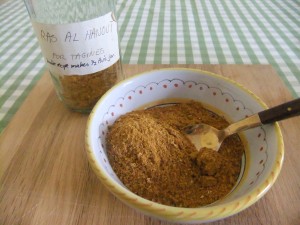
Ras al hanout
Makes ½ a medium size jar of ras el hanout:
2 teaspoon ground cumin
2 teaspoon ground ginger
3 teaspoon turmeric
1½ teaspoon ground cinnamon
1½ teaspoon freshly ground black pepper
1 teaspoon ground white pepper
1 teaspoon ground coriander seeds
1 teaspoon cayenne
1 teaspoon ground allspice
1 teaspoon ground nutmeg
½ teaspoon ground cloves
Instructions: Mix spices together. Store airtight in a dark place to preserve the potency of the spices.
How to make preserved Lemons
These have a distinctive flavour its hard to replicate. These are easily made if you cant find a local Halal shop near you or don’t live near Fallon & Byrne. They take at least 2 weeks before they are ready and will keep for a year. I usually keep mine in the fridge but its not absolutely necessary.  These take about 2 weeks to mature.
These take about 2 weeks to mature.
A carton of Atlantic sea salt or Himalayan (pink) salt
10 unwaxed lemons, organic if possible, scrubbed well
A large glass jar with lid
1. Standing a lemon on one end make a cut down the centre with a sharp knife until you have cut 2/3 of the way down.
2. Now turn the lemon upside down and rotate it 90 degrees. Make another cut at right angles to the original cut, also 2/3 of the way down the fruit.
3. Pack the slits with salt and place in the jar. Continue until the lemons are all packed tightly in the jar.
4. Over the next week or two you will see liquid coming out of the lemons. This is normal. When using a lemon for cooking you will need to discard the seeds and rinse off the salty liquid. After 2 weeks the lemons are ready to use.
Why this is good for you:
Spices in the ras al hanout are a fantastic source of antioxidants to help your health. Spices help reduce inflammation in the digestive system. Research shows that spices also boost liver function and help keep your skin clear and young-looking. Traditionally, Moroccan dishes are cooked on a low flame for a long time. Modern, cheffy recipes telling you to brown the meat are neither as authentic nor as healthy as the traditional ways. Cooking foods at low temperature (stewing) rather than at high temperature (frying, roasting or grilling) is better because low temperatures produce far fewer damaging free radicals than high temperature cooking. Fewer free radicals and more antioxidants from the spices means slowing down the ageing process, reducing the risk of chronic or life-threatening disease, and helping your heart. Stewing meat on the bone releases substances into the food that help support collagen production. This helps your digestive system repair itself and also helps maintain good firm skin and bones in later life.

Jul 22, 2013 | Anna's Best Recipes, Main courses
Tonight, we ate these gorgeous chicken pieces. Instead of the roast Mediterranean veg in the recipe, we piled them onto a bed of baby spinach leaves alongside green beans dressed with lemon juice, black pepper, and a little Himalayan salt. If you don’t want to lose any weight, you could add some potatoes. This way of roasting chicken pieces is a real crowd-pleaser.
The paste keeps for a couple of weeks in an airtight jar in the fridge. The chicken is even better if you let it sit in the paste for a while or overnight in the fridge. It’s still great if you slather it on just before cooking. Using a miniature food processor gives a really creamy texture to the paste and saves lots of effort.
For 2
2 whole chicken legs, small breasts on the bone, or fillets, ideally organic.
2 whole red or yellow peppers, washed but not cut open
2 large fat courgettes
A few small/medium sized sweet potatoes or normal potatoes in their jackets (optional – omit if this is your evening meal and you want to lose weight or if you are following a ketogenic eating plan)
2 red onions (optional)
Garlic-spice paste:
12 large cloves garlic, peeled
3 tbsp extra virgin olive oil
1 lemon, juiced
1 level tsp ground cinnamon
¾ teasp ground allspice
¼ teasp freshly ground black pepper
A good pinch of cayenne pepper
1. Preheat the oven to 200C/400F/gm 6
2. Blitz all the spice paste ingredients together in a small food processor. Otherwise crush the garlic and mix well with the other ingredients – the sauce will not cling so well but is still fine.
3. Slather enough of the paste on the chicken to coat well and place in a large roasting dish (you will have a fair bit left over to drizzle over baked sweet potatoes, to use another time to grill some white fish, or to serve as a spicy accompaniment )
4. Prepare whatever vegetables you are using: Wash the peppers (do not cut anything out as, cooked whole, the pepper will fill up with delicious sweet juices while cooking); wash the courgettes and cut into 7cm lengths;
Scrub the potatoes if using. Peel and halve the red onions if using and brush with a little olive oil
Spread out the veg in a single layer with the chicken in the roasting dish.
5. Bake for 50 mins in the oven or until the chicken juices run clear when the meat is pierced with the point of a knife. Chicken fillets may cook faster if they are small so check these after 30 mins (remove from the oven if done while the rest of the veg finish cooking).
Cook’s Tip for Kids Eating:
Many children dislike seeing seeds so try halving the peppers, removing the seeds and in each pepper place a tomato half and a teaspoon of olive oil before putting in the oven. This helps the pepper avoid drying out.
Dietary note:
Garlic and spices in your diet are a fantastic health booster – for liver and skin health, immunity and delaying the effects of ageing. If you cannot source organic chicken then its best to avoid fattiest part of the bird (legs, thighs, skin) and eat only the breast. Battery chickens are routinely dusted with pesticides which congregate in the fatty tissues of the bird.

Jul 19, 2013 | Anna's Best Recipes, Main courses
We made this on Wednesday night using leftovers from the pot roast chicken we cooked on Monday. We doubled up the quantities so as to have effortlessly packed lunches the following day. Spouse was ravenous so I cooked an extra 60g of brown rice noodles (which I dressed with a little tamari sauce and a teaspoon of cold-pressed sesame oil) for him as a side. This recipe is suitable for a ketogenic diet if you omit syrup, coconut sugar, or xylitol. If you have a problem with raw onions, try soaking them in the dressing for 20 minutes before adding the other ingredients, this takes the heat out of them.
For 2:
160g cooked chicken (organic if possible), shredded or sliced
4 cups raw, shredded cabbage red, white or green
1 medium carrot, cut into strips with a potato peeler or julienned (in thin matchsticks)
3 spring onions, including green part, cut into long thin strips OR 1/2 a medium/large red onion, halved, then sliced thinly
2 tbsp coarsely chopped or torn mint leaves
Mint and coriander sprigs to garnish
Dressing
1 tbsp fresh lime juice
1 tbsp oriental fish sauce
1 tsp white wine vinegar or rice vinegar if you have it
1 crushed clove garlic
1 DSP coconut sugar, agave or maple syrup, or xylitol (optional) (omit for ketogenic diet)
1 tbsp cold-pressed (virgin) sesame/peanut/sunflower/macadamia/rapeseed oil (if you cannot get any of these as the cold-pressed oil, do not use any oil at all)
1 red chili, de-seeded and finely chopped (optional)
1. For the dressing: put the lime juice, fish sauce, vinegar, garlic & coconut sugar, syrup or xylitol, oil, and chilies in a bowl and whisk so the sugar/xylitol dissolves. Leave for 30 minutes for the flavours to develop.
2. Mix in the salad ingredients and divide between 2 plates or bowls.
3. Garnish with mint and coriander sprigs.
If this is your evening meal and you’re not wanting to lose weight, serve with brown rice or 100% buckwheat or brown rice noodles sprinkled with a little Tamari sauce (from Asian shops). Omit noodles for a ketogenic diet.
Dietary note:
Tamari is a delicious, naturally gluten-free soya sauce, and buckwheat and brown rice are naturally gluten-free too. Cabbage contains folic acid and cabagin which are both very healing for the digestive system, especially if you have gastritis or ulcers. Surprisingly, chilies can have a pain-relieving effect on ulcers and are used in ayurvedic medicine as an ulcer treatment. The virgin, cold-pressed nut and seed oils mentioned in the recipe, eaten raw, are a rich source of omega 6 essential fats. Essential fats are needed for clear skin, digestive wellness, and energy production. Trans fats, generated during standard (non-cold) processing of oils and also during cooking, are harmful. They damage the body and block essential fat utilization. Herbs and spices are high in antioxidants for many health benefits. The reason some people do not tolerate raw onions is they relax the esophageal sphincter. This is the valve that stops food from coming back up towards your gullet. If you have acid reflux, it means that this valve could do with being strengthened by specific dietary measures.

Jul 17, 2013 | Anna's Best Recipes, Main courses
I found this recipe in a magazine once. No idea who it’s by but it’s lovely and is our favourite method of roasting a chicken. On Monday evening we cooked this and ate it lukewarm with a mixed salad in the garden. Normally we eat it with lots of steamed green or runner beans, or cabbage and maybe a small baked sweet potato or some steamed mashed carrots. If you are on a ketogenic eating plan, omit the root vegetables. I keep all the bones in a dish in the fridge for up to 4 days (or in the freezer) to make stock.
For 4, or 2 with lots leftover:
1 organic chicken
2-4 garlic cloves
Olive oil
A pinch of Himalayan or Atlantic Sea Salt
Freshly ground black pepper
2 tbsp roughly chopped fresh tarragon OR 1 dsp dried tarragon or 1 heaped dsp finely chopped fresh rosemary OR 1 large handful of washed thyme sprigs
1 lemon, halved
A heavy-bottomed ovenproof casserole (or pyrex) dish with a lid
1. Preheat the oven to 200C. Discard any giblets inside the chicken.
2. Peel and cut the garlic cloves in half lengthways. Use a sharp-pointed knife to make 8 deep slits in the fleshiest parts of the chicken – thighs, breasts – and push the garlic halves well down into these. If you can’t face slitting and pushing garlic into the slits, just throw unpeeled garlic around the bird to eat hot when the whole thing is cooked.
3. Put 1 lemon half inside the bird, smear the upper part of the chicken with olive oil, and put into an ovenproof casserole dish with a lid. Add the second lemon half to the pot. Season with the salt and pepper and sprinkle with the tarragon or rosemary, or scatter the thyme over and around the bird. The reason I don’t destalk and chop the thyme is that it’s a pain and the leaves fall off during cooking anyway so why bother? If you are a real garlic fan, as I am, you can scatter any spare unpeeled cloves of garlic into the casserole dish now – they will be delicious squeezed hot from their skins to go with the cooked chicken.
4. Cover with a lid, cook 30-40 mins, then reduce heat to 150C and cook for a further hour.
5. Test by sticking a knife into the thigh. If the juices run clear the bird is cooked.
6. Allow the bird to rest on a warm plate for 20 minutes or so after taking it out of the oven. This makes the meat easier to cut, and moister than if you carve straight away. Cook your vegetables or prep your salad while the meat is resting. If this is your evening meal and you are on a ketogenic eating plan or want to lose weight, omit the root vegetables (carrots, potatoes etc.).
7. If you serve this hot, spoon over the herby, lemony juices.

Jul 4, 2013 | Anna's Best Recipes, Cook-in sauces, Dressings, rubs, spreads, sauces & more, Main courses
We ate this last weekend after arriving back from a few days away, desperate to get away from bland food. This is a beautiful, aromatic cook-in sauce for vegetables, white fish or lean meat. People always ask for the recipe when I serve it up. It is equally nice with fish, chickpeas, or chicken. You could also use it to reheat leftover cooked lamb or beef or as a cook-in sauce for peeled prawns. It stores well in the freezer so you could make a large batch, freeze in individual portions, and thaw as needed. this amount of sauce is enough for 4 people, or 2 with leftover sauce to put in the freezer.
3 medium onions
3cm piece fresh ginger
2 large fat cloves garlic (optional)
1 tbsp virgin coconut oil (or olive oil if you can’t get coconut)
1 rounded tsp ground coriander
1 level tsp ground cardamom
1/2 level tsp ground cloves
1 level tsp ground cinnamon
1 rounded tsp turmeric
1/3–½ level tsp chilli powder (optional – avoid if you don’t like heat!)
1 x 65ml tin coconut milk (or 60g creamed coconut + 300ml/1¼ cups boiling water)
300ml/1¼ cups passata (sieved tomatoes) or 1 tin tomatoes, liquidized
1 tbsp chopped fresh coriander
Pepper
A food processor/liquidiser
1. Finely dice the onion, grate the ginger and crush the garlic. Place in a saucepan with the coconut oil or olive oil and 1 tbsp water and sweat them with the lid on over a low heat until the onion begins to soften/go translucent.
2. Add the spices and sweat for a few more minutes.
3. If using creamed coconut, dissolve it in the boiling water and place it in a food processor. If using coconut milk place in the processor with around 200ml water. Add two-thirds of the onion mixture and process until smooth.
4. Put the processed mixture back into the pan and add the passata and fresh coriander. Simmer for 5 mins, then season to taste with pepper.
5. Freeze in containers ready for future use or use for cooking any of the ideas below.
6. Serve with brown rice.
Cook-in ideas (just heat sauce in a heavy-bottomed saucepan to prevent burning, add your ingredients to be cooked, then cover with a lid):
- Fish & veg: Allow 100-120g white fish (skinned and cut into 2.5cm cubes) and 2 cups of broccoli florets or thawed/fresh peas per person. If using broccoli, cook it in the sauce until almost done, then add the fish, which only takes a few minutes. If using peas, you can add the fish and peas at the same time.
- Chicken & veg: Allow 100g chicken fillet (cut in 1cm slices or 2cm cubes) plus 2 cups sliced runner beans or broccoli florets per person. Heat the sauce, add everything else, cover with a lid and cook till done, stirring occasionally (around 10 minutes).
- Chickpeas & veg: Allow 1 cup of cooked drained chickpeas plus 2 cups green veg (eg. broccoli florets or green beans) per person. Throw the whole lot into the simmering sauce, cover with a lid and cook for around 8 minutes until the vegetables are softened but not overcooked.
Why this is good for you:
Research shows that all spices have anti-aging, antioxidant, health-boosting properties. Onions and garlic are great sources of soluble fibre, which feeds the helpful gut bacteria needed for proper digestion, mental clarity, and clear skin. Soluble fibre also binds to natural and man-made toxins (such as chemicals, used-up hormones, and medications) in your digestive system, ensuring that they exit the body quickly and as safely as possible.



